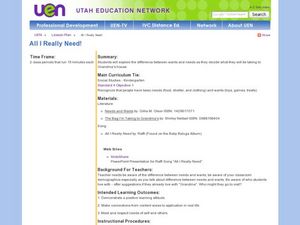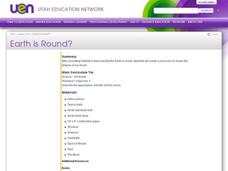Curated OER
Rock-A-Bye Pendulum
Third graders analyze the effects of force on an object in motion and its relationship to a change in speed. This lesson uses a pendulum to demonstrate the principle.
Curated OER
Walk in My Shoes
Learners discover how culture, geography and history affect how someone views an area of the world. They role play the role of a Palestinian, Jew or Briton and examine how they felt about Israel during its formation. To end the lesson,...
Curated OER
A Quilt of Many Colors
First graders learn the "Quilt Song." They brainstorm items they could draw that would remind them of the person in the song. Students work in groups to complete a "Person Outline" page (included with the activity). They draw one part of...
Curated OER
Analyzing the Job Market for Babysitting in Your Neighborhood
Students conduct research on a neighborhood in Canada. In this data analysis lesson, students use data from the 2006 Canadian census to draw conclusions about a population group.
Curated OER
Angles, Triangles, Quadrilaterals, Circles and Related
Middle schoolers classify angles. For this angles lesson, students explore the characteristics of angles, triangles, quadrilaterals and circles. They identify polygons and sing a classifying angles song. Middle schoolers participate...
Curated OER
Place value concepts
Third graders participate in classroom game to practice place value skills. In this place value lesson, 3rd graders recognize matching digits of the same value. Students record their numerals and their value by writing in standard...
Curated OER
Playing with Remainders
Fifth graders explore how people handle remainders in real life. For this remainders math lesson, 5th graders participate in skits to show what to do with remainders. Students complete worksheets with word problems.
Curated OER
The Earth is Flat
Third graders experiment to gain understanding of the shape and rotation of the Earth. In this Sun and Moon science lesson, 3rd graders understand that the Earth rotates on its axis and how that explains the appearance of the moon and sun.
Curated OER
The New Texas Two-Step
Sixth graders work with mathematical expressions by interpreting, analyzing and problem solving with them. In this two step algebraic problem solving instructional activity, 6th graders use algebra tiles to solve equations.
Curated OER
All I Really Need!
Students differentiate between wants and needs. In this basic needs activity, students prepare to pack for a trip to grandma's house and determine what they need for the trip and what they want for the trip.
Curated OER
Meet the People In Your Neighborhood
First graders recognize various occupations and their roles in the community. In this communities lesson, 1st graders read the story I Stink and view a Powerpoint presentation of "Community Helpers." Students create a costume to...
Curated OER
Making Cookies- How many per hour?
Fifth graders measure how long it takes to make cookies. In this measuring time activity, 5th graders explore how to manage time. Students decide when to start making breakfast on time, how to calculate playing time into their lunch...
Curated OER
Calculating Population Growth for a Region
Young scholars research population growth of regions of Canada. In this Social Studies lesson, students use included links on the Internet to find information about population growth in areas of Canada. A worksheet for each region is...
Curated OER
Distribution of children living at home
Students use E-STAT to examine demographics. In this social demographics lesson, students use statistical data to determine if a particular family is in need of assistance. Students will discuss social and educational policies and...
Curated OER
Who's Responsible - You Or Your Parents?
Students watch a news clip about people who think bad parents are to blame for bad kids. They then take a quiz about legal age and responsibility. Finally they design a series of parenting lessons.
Curated OER
Earth is Round?
Third graders discuss how Aristotle concluded that the Earth was round. As a class, they review theories about the Earth's shape and describe how life on Earth would be different if it were flat. Individually, they make a moon book in...
Curated OER
Trait Variations for Survival
Young learners examine how different traits could give one organism an advantage over another. In groups, they view two different organisms in different environments. To end the lesson plan, they complete a Venn Diagram on the two...
Curated OER
Women's History Week
Students investigate the contributions of women who influenced human rights in US history. They examine the influence Susan B. Anthony, Harriet Tubman, Sojourner Truth and Elizabeth Cady Stanton by participating in a jigsaw activity....
Curated OER
Responsibilities of Parenting
Students sign the job sheet, scenario sheet and Lucky day and Bad day sheets and select one of the jobs from the provided list. Then, they meet and decide who will go to which stores. Students also role play a particular scenario as...
Curated OER
How Many People Live in Your Household?
Students create a pictograph showing household size for the class.In this data collection and graphing lesson, the teacher guides students through the creation of a concrete object graph, then students analyze and summarize the results.
Curated OER
What Is a Foundation?
Students explore the concept of grants. In this philanthropy lesson, students meet a grant-writer and then collaborate to prepare a grant request.
Curated OER
Common Good in Aztec Culture
Students investigate the Aztec religion and its symbols. In this Aztec religion lesson, students develop understanding of why the Aztecs gave sacrifices. Students write an essay looking at the Aztec religion and can explain its...
Utah Education Network (UEN)
Order of Operations Treasure Hunt
In this algebra lesson, students work in groups to design a treasure map in which algebraic equations must be solved using the correct order of operations. Students decide where treasure is hidden, then create and follow their group's...
Curated OER
Box It Up
Fifth graders make boxes. In this prisms lesson, 5th graders read the book Counting on Frank and discuss the different things that the boy measures. Students make boxes of various sizes using graph paper and find their volume.

























